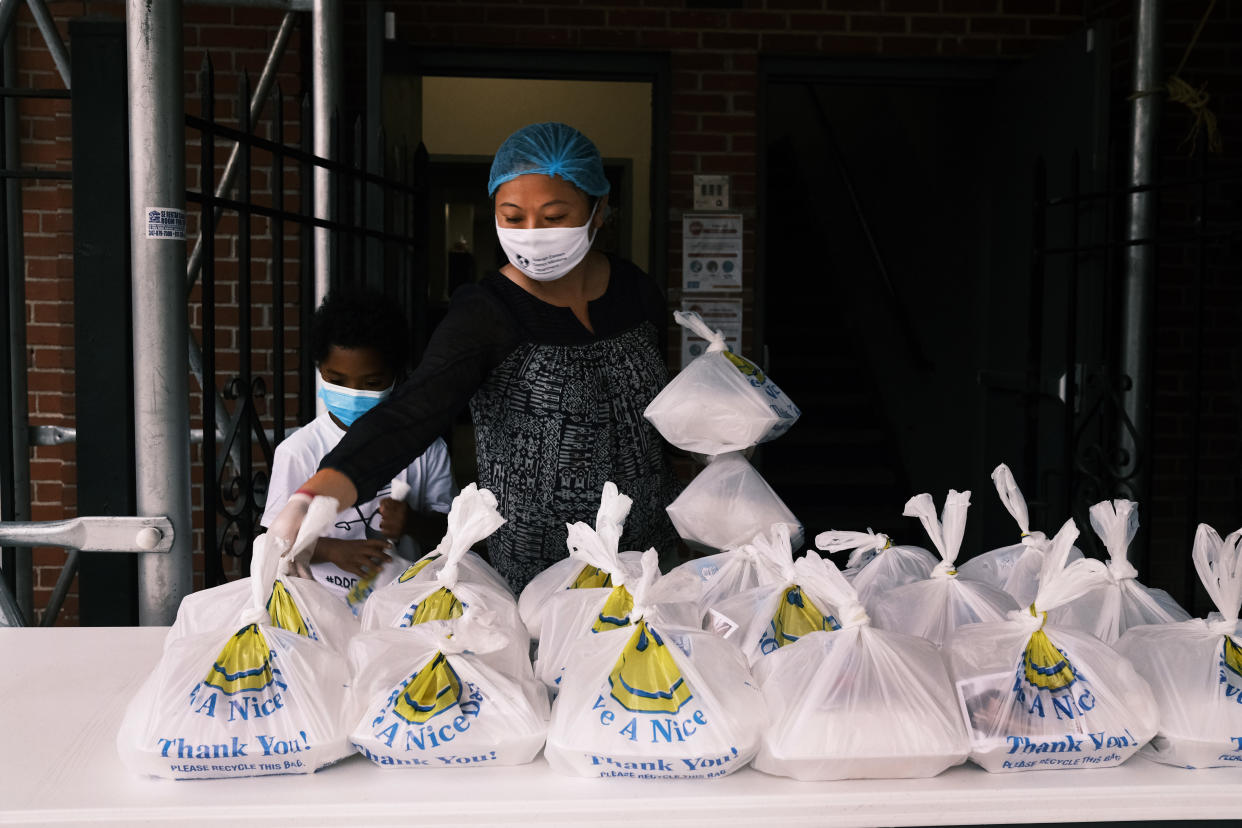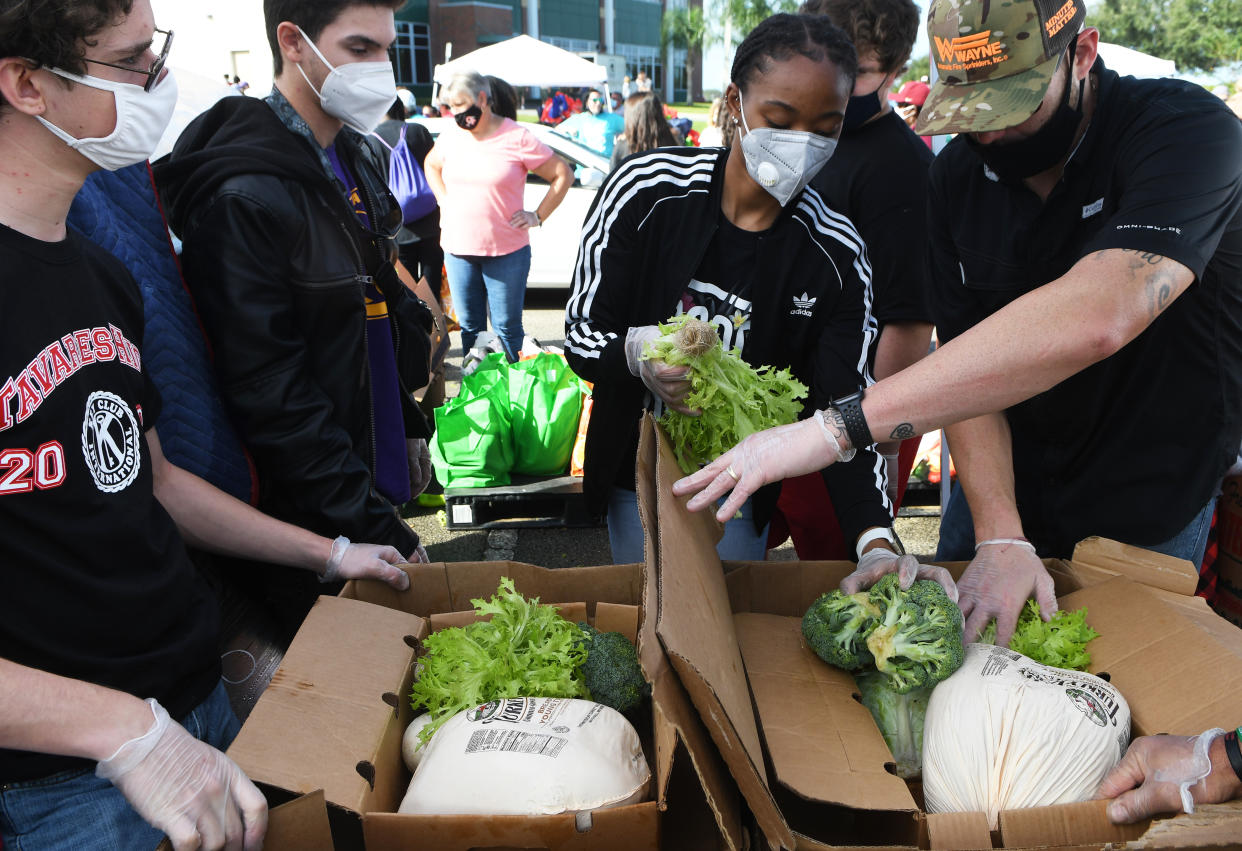How soup kitchens and shelters are serving Thanksgiving meals amid the pandemic — and how you can volunteer safely

For many Americans, Thanksgiving isn’t just a day of feasting of family catch-ups and post-turkey naps. It’s about taking that message of gratitude to heart by giving back to others, often by donning an apron, hairnet and latex gloves and dishing out portions of mashed potatoes and green bean casserole at a local soup kitchen or shelter. This year, thanks to the widespread food insecurity and economic hardship brought on by the coronavirus pandemic, more and more people are in need of a hot meal. But with cases in the U.S. spiking and health officials raising alarms about the risk of gathering, even for a good cause, nonprofits and the volunteers they rely on are facing new challenges on how to get folks fed safely.
Last week, COVID-19 concerns prompted the City of Toledo Department of Neighborhoods in Ohio to cancel its 23rd annual Thanksgiving luncheon for the homeless and underhoused the day before it was due to take place. The cancelation came after organizers for the event, which was to be held at a local Greek Orthodox church, had already pivoted to a grab-and-go set-up rather than a sitdown meal, and scrapped the on-site social services and free haircuts and manicures usually on offer out of an abundance of caution. According to a press statement, the city plans to instead liaise with shelters and food banks across the city to distribute food on a smaller scale.
But countless other groups — from ministries to food banks to shelters — are planning to forge ahead with their Thanksgiving Day meals, albeit with new COVID-19 protocols in place. By and large, that means replacing trays of hot food with bagged lunches and individually portioned to-go meals that can be eaten elsewhere, in a bid to reduce crowds, avoid indoor activity and buffet-style serving, and keep staff and volunteer support numbers to a minimum.
In Texas, volunteers at the homelessness nonprofit Caritas of Austin will serve 200 (per day) hot, to-go Thanksgiving meals — which include a roast turkey with giblet gravy, pumpkin pie, cornbread dressing with jalapeno sausage and other traditional sides — on Tuesday and Wednesday before closing for the week. Communications manager Julie Burch tells Yahoo Life that, in the past, guests have enjoyed their Thanksgiving meals in the Caritas dining room, but, due to the pandemic, the community kitchen has been closed to inside dining since mid-March. A scaled-back volunteer crew now prepares the bagged lunches handed out daily.
“For the past few months, we have started letting volunteers help prepare meals again but rather than the normal 10 volunteers, we have limited it to two or three people so that we can maintain safe distances,” Burch explains. “All surfaces are sanitized before and after preparation, everyone wears a mask, washes hands and wears gloves. We are taking health and safety seriously.”
Some groups will offer care packages and hot turkey dinners in a drive-through format to limit contact. In Saginaw, Mich., the Dawn of a New Day Coffee House and Cafe is stepping up to meet the growing demand by providing drive-by meals, while the Roanoke Rescue Mission in Virginia will let members of the community choose between a to-go Thanksgiving dinner served curbside, or a socially distant indoor dining experience, according to local outlet WSLS; those spending the night at the shelter can dine in their rooms.
While many nonprofits are anticipating a bigger turnout for meals this Thanksgiving, volunteers may be less plentiful — partly because some operations have been reduced in scale, and partly because those who might normally pitch in, including retirees who may be high-risk, are staying home over COVID-19 concerns. The Los Angeles Regional Food Bank, for example, notes that “volunteer activity has declined”; those that do volunteer are subject to temperature checks and age restrictions (18 and older only for the time being) and must follow strict social distancing and sanitizing measures. Those deemed high-risk because of their age or medical history are discouraged from volunteering amid the pandemic.
Torn over whether or not to carry on your family’s Thanksgiving Day tradition of helping out the hungry and homeless this year? There are two things to consider right off the bat: your community’s level of COVID-19; your health, including conditions that might put you at risk, or conversely, any exposure that could potentially endanger others in your presence. According to the Thanksgiving guidelines issued by the Centers for Disease Control and Prevention, factors like whether or not you’ll be working indoors or outdoors, the length of time involved and the possibility of crowding among people from different households should also inform your decision. And with some volunteer opportunities scaling back, it’s possible that your in-person services may not be needed as they work to keep numbers low.

While the CDC doesn’t specifically address Thanksgiving volunteer opportunities — though cooking a meal at home and delivering it contact-free to someone in need is ranked as a lower-risk activity, while attending crowded events, such as a parade or sports race, is considered high-risk — there is a separate protocol for food pantries and food distribution sites, which acknowledges the ongoing food insecurity amid the pandemic. This includes providing contactless options like drive-throughs, limiting staff, volunteer and client numbers in order to maintain at least 6 feet of social distance and training volunteers on safety measures, such as wearing face masks and disposable gloves and practicing thorough hand-washing (at least 20 seconds, with soap and water, plus a hand-washing break every two hours).
If volunteering in person feels too risky, or you can’t find opportunities in your area due to limits on capacity, making a donation to a local nonprofit or food pantry project is another important way to support their work to feed those in need. Consider making that donation a financial one, rather than clearing your pantry of whatever non-perishable items you haven’t gotten around to using yourself. As Caritas of Austin spokesperson Julie Burch notes, “monetary gifts allow us to use the funding where it is needed most.”
Nonprofits may be able to put the money toward housing programs or other services and have vendor relationships and other channels that’ll help them stretch those donated dollars into creating nutritious meals suitable for large groups. That said, food banks and the like do have specific needs — say, toothpaste, cans of beans, chips or crackers for sack lunches, et cetera — that they’ll typically outline on their website. Caritas, for example, has an Amazon Wish List that will send donated purchases directly to them, while Rappahannock Pantry in Sperryville, Va. has requests for items such as eggs, canned meat and pet food in addition to financial contributions.
And don’t discount the gift of goodwill. In addition to calls for food and financial donations, Feeding America invites members of the public to sign a virtual Thanksgiving card that’ll pass on holiday greetings and messages of support to families using a food bank. The hunger-relief organization also notes that there are opportunities for virtual volunteering, which could include fundraising or raising awareness online — all without leaving the house.
For the latest coronavirus news and updates, follow along at https://news.yahoo.com/coronavirus. According to experts, people over 60 and those who are immunocompromised continue to be the most at risk. If you have questions, please reference the CDC’s and WHO’s resource guides.
How to maintain your physical and mental health during the pandemic
Taking care of a loved one with COVID-19? Here’s how to stay healthy
Q&A with Dr. Kavita Patel: How to keep your family safe and maintain your mental health
Read more from Yahoo Life:
CDC confirms masks also protect the wearer, outlines which ones are most effective
COVID-19 cases, deaths spike in rural America: 'It was only a matter of time'
Want lifestyle and wellness news delivered to your inbox? Sign up here for Yahoo Life’s newsletter.

